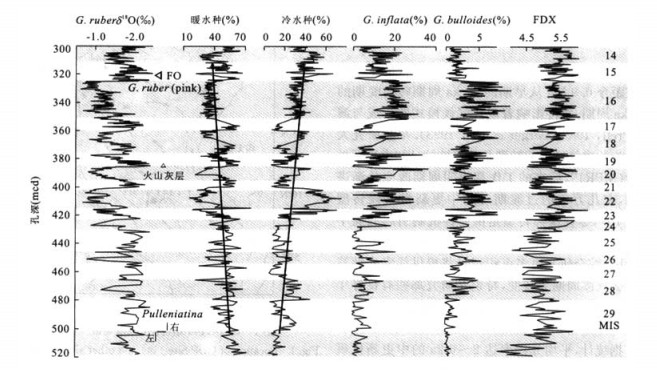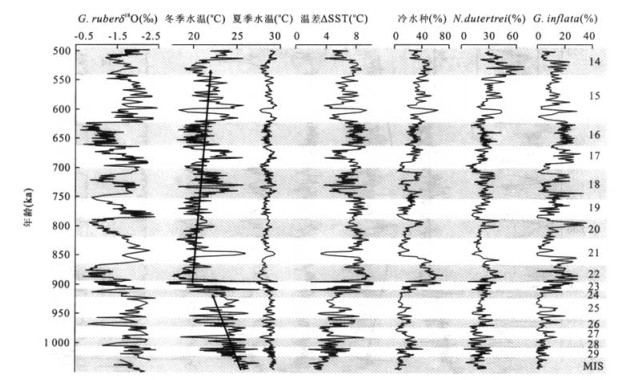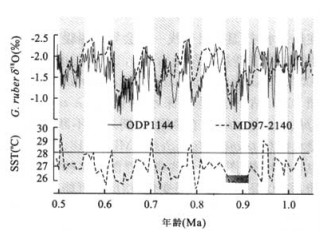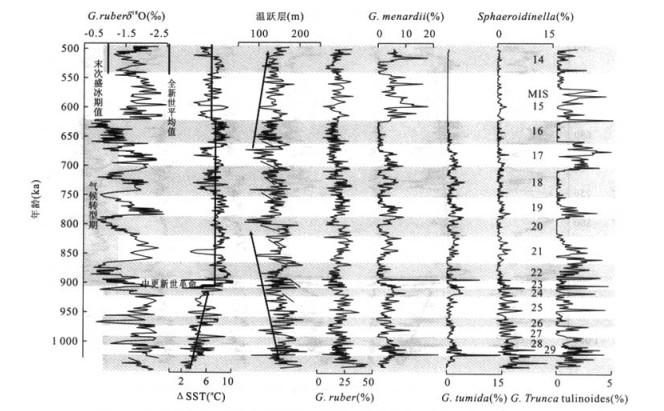A Millennial Scale Mid-Pleistocene Paleoclimate Record of Planktonic Foraminifera from the Northern South China Sea Site 1144
-
摘要: 南海北部ODP1144站中更新世气候转型时期的浮游有孔虫在千年尺度上以高频率变化为主要特征.冰期旋回主要周期在0.9Ma由41ka转变为100ka, 浮游有孔虫组合也随冰期旋回出现大量的冷水种.据转换函数得出的表层水降温高达10℃发生在0.9~0.6Ma间的转型过渡期, 跨越MIS22、20、18、16四大冰期.同时, 温跃层深度呈阶梯式变浅, 在MIS20上升至65m左右.所以, 南海北部上层水体环境在中更新世气候转型期出现比末次冰期更重的δ18O值, 温跃层变浅, 深水种含量降低或消失, 突出了边缘海区南北气候梯度反差和冬季风在冰期增强的讯号.南海南北部的环境差异与东西太平洋的差异, 共同表明低纬过程在气候变化中的重要性.Abstract: Planktonic foraminifera results from ODP Site 1144 in the northern South China Sea indicate that the Mid-Pleistocene climate transition is characterized by high-frequency changes on the millennial scale. In pace with glacial-interglacial cycles after the dominant glacial cyclicity shifted from 41 ka to 100 ka over the ~0.9 Ma, sudden increases in the abundance of cool-water planktonic foraminifera species became more evident. The SST variations estimated from transfer function show large decreases of up to 10 ℃ during the four major glacial periods of MIS22, 20, 18 and 16 between 0.9-0.6 Ma. Cooler conditions in glacial times also caused the thermocline depth to shoal in steps to a minimum of about 65 m at MIS20. Therefore, during the Mid-Pleistocene climate transition, the upper ocean water environment in the nouthern South China Sea was marked by δ18O values heavier than the last glacial maximum, a shoaled thermocline, and significant decrease to almost complete absence of several deep-water planktonic foraminiferal species, amplifying the paleoclimatic signals of SST contrasts between the northern and southern South China Sea and a strengthened winter monsoon on the millennial scale. Together with the E-W equatorial Pacific record, the N-S contrasts in the South China Sea demonstrate the significance of low latitude process in climate change.
-
Key words:
- glacial cycle /
- Mid-Pleistocene /
- climate transition /
- winter monsoon /
- planktonic foraminifera /
- South China Sea.
-
图 1 ODP 1144站位图(Wang et al., 2000)
箭头指示夏季主要表层水流方向
Fig. 1. Location of ODP Site 1144 and other site localities in the South China Sea
图 2 ODP 1144站氧同位素分期MIS14-29 (Bühring et al., 2004)、生物/地层事件、主要浮游有孔虫丰度和浮游有孔虫溶解指数
箭头分别代表暖水种群和冷水种群丰度在长尺度上的变化趋势
Fig. 2. ODP Site 1144 oxygen isotopic results, showing marine isotope stages (MIS) 14 to 29 (Buhringet al., 2004), faunal-stratigraphic events, abundance of major planktonic foraminifera and FDX
图 4 南海ODP 1144站δ18O与开放西太平洋MD97-2140孔δ18O和Mg/Ca平均水温对比(De Garidel-Thoron et al., 2005)
Fig. 4. Comparison between ODP Sites 1144 δ18O and MD97-2140 δ18O and Mg/Ca-derived SST from the open West Pacific
-
Aguado, E., Burt, J., 2001. Understanding weather and climate. 2nd Edition. Prentice Hall, Indiana USA. Berger, W. H., Bickert, T., Jansen, E., et al., 1993. The central mystery of the Quaternary ice age. Oceanus, 36: 53-56. Berger, W. H., Jansen, E., 1994. Mid-Pleistocene climateshift—The Nansen connection. Geophys. Monograph, 84: 291-311. Bühring, C., Sarnthein, M., Erlenkeuser, H., 2004. Toward ahigh-resolution stable isotope stratigraphy of the last 1.1 million years: Site 1144, South China Sea. Proc. ODP Sci. Results, 184: 1-29. De Garidel-Thoron, T., Rosenthal, Y., Bassinot, F., et al., 2005. Stable sea surface temperatures in the western Pacific warmpool over the past 1.75 million years. Nature, 433: 294-298. doi: 10.1038/nature03189 Jian, Z. M., Wang, P. X., Chen, M., et al., 2000. Foraminiferal responses to major Pleistocene paleocean-ographic changes in the southern South China Sea. Paleoceanography, 15: 229-243. doi: 10.1029/1999PA000431 Kennett, J. P., Srinivasan, M. S., 1983. Neogene planktonic foraminifera: A phylogenic atlas. Hutchinson RossPubl. Co., New York. Li, B. H., Wang, J., Huang, B., et al., 2004. South China Seasurface water evolution over the last 12 Myr: A south-north comparison from ocean drilling program sites 1143 and 1146. Paleoceanography, 19: PA1009, doi: 10.1029/2003PA000906. Pflaumann, U., Jian, Z., 1999. Modern distribution patterns of planktonic foraminifera in the South China Sea and western Pacific: A newtransfer technique to esti mate regional sea-surface temperatures. Mar. Geol., 156 (1-4): 41-83. doi: 10.1016/S0025-3227(98)00173-X Prell, W. L., 1982. Oxygen and carbon isotope stratigraphyof the Quaternary of Hole502B: Evidence for twomodes of isotopic variability. Init. Repts. DSDP, 68: 455-464. Raymo, M. E., Oppo, D. W., Curry, W., 1997. The mid-Pleistocene climate transition: A deep sea carbonisotopic perspective. Paleoceanography, 12: 546-559. doi: 10.1029/97PA01019 Raymo, M. E., Oppo, D. W., Flower, B. P., et al., 2004. Sta-bility of North Atlantic water masses in face of pro-nounced climate variability during the Pleistocene. Paleoceanography, 19: PA2008, doi: 10.1029/2003PA000921. Ruddiman, W. F., Raymo, M. E., Martinson, D. G., 1989. Pleistocene evolution: Northern hemisphere ice sheetand North Atlantic Ocean. Paleoceanography, 4: 353-412. doi: 10.1029/PA004i004p00353 Rutherford, S., D Hondt, S., 2000. Early onset and tropical forcing of 100000 year Pleistocene glacial cycles. Nature, 408: 72-75. doi: 10.1038/35040533 Schmieder, F., Von Dobeneck, T., Bleil, U., 2000. The Mid-Pleistocene climate transition as documentedin the deepSouth Atlantic Ocean: Initiation, interi mstate and terminal event. Earth Planet. Sci. Lett., 179 (3-4): 539-549. doi: 10.1016/S0012-821X(00)00143-6 Shackleton, N. J., 2000. The 100000 year ice-age cycle iden-tified and found to lag temperature, carbon dioxide, andorbital eccentricity. Science, 289: 1897-1902. doi: 10.1126/science.289.5486.1897 Shackleton, N. J., Berger, A., Peltier, W. R., 1990. An alter-native calibration of the lower Pleistocene timescalebased on ODP Site 677. Trans. Royal. Soc. Edinburgh Earth Sci., 81: 251-261. doi: 10.1017/S0263593300020782 Shao, L., Li, X. H., Wei, G. J., et al., 2001. Provenance of aprominent sediment drift on the northern slope of theSouth China Sea. Science in China (Series D), 44: 919-925. doi: 10.1007/BF02907084 Sun, X., Luo, Y., Huang, F., et al., 2003. Deep-sea pollenfromthe South China Sea: Pleistoceneindicators of East Asian monsoon. Mar. Geol., 201: 97-118. doi: 10.1016/S0025-3227(03)00211-1 Thompson, P. R., 1981. Planktonic foraminifera in the WestNorth Pacific during the past 150000years: Comparisonof modern and fossil assemblages. Palaeogeogr. Palaeocli matol. Palaeoecol., 35: 241-279. doi: 10.1016/0031-0182(81)90099-7 Tian, J., Wang, P. X., Cheng, X. R., 2004. Development of the East Asian monsoon and North Hemisphere glaciation: Oxygen isotope records from the South China Sea. Quat. Sci. Rev., 23: 2007-2016. doi: 10.1016/j.quascirev.2004.02.013 Wang, L., Sarnthein, M., Erlenkeuser, H., et al., 1999. East Asian monsoon climate during the Late Pleistocene: High-resolution sediment records fromthe South China Sea. Mar. Geol., 156: 245-284. doi: 10.1016/S0025-3227(98)00182-0 Wang, P. X., Prell, W. L., Blum, P., et al., 2000. Proceed-ings of the Ocean Drilling Program, Initial Reports 184, College Station, TX. Wang, P. X., Tian, J., Cheng, X. R., et al., 2001a. Carbonreservoir changes proceded major ice-sheet expansion atthe mid-Brunhes event. Geology, 31: 239-242. Wang, P. X., Tian, J., Cheng, X. R., 2001b. Transition oQuaternary glacial cyclicity in deep-sea records at Nansha, the South China Sea. Science in China (Series D) 44: 926-933. Xu, J., Wang, P. X., Huang, B., et al., 2005. Response of planktonic foraminifera to glacial cycles: Mid-Pleisto-cene change in the southern South China Sea. Marine Micropaleontology, 54: 89-105. doi: 10.1016/j.marmicro.2004.09.005 Zhao, Q. H., Jian, Z. M., Li, B. H., 1999. Microtektites in the Middle Pleistocene deep-sea sediments of the South China Sea. Science in China (Series D), 42: 532-535. -









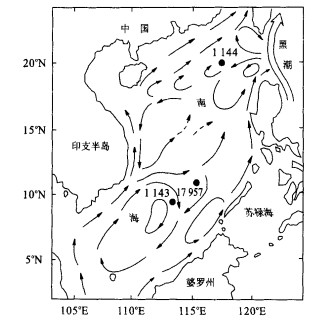
 下载:
下载:
